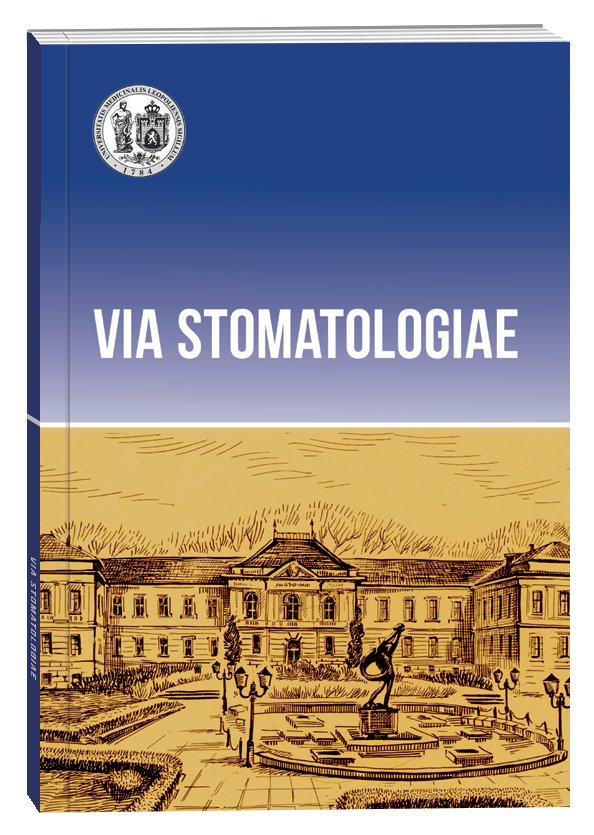ВИЗНАЧЕННЯ ОСОБЛИВОСТЕЙ КОНТУРІВ ДНА ВЕРХНЬОЩЕЛЕПНИХ ПАЗУХ У ПАЦІЄНТІВ ІЗ РІЗНОЮ ФОРМОЮ ЛИЦЕВОГО СКЕЛЕТА ПІД ЧАС ПІДГОТОВКИ ДО ОПЕРАЦІЇ ВІДКРИТОГО СИНУС-ЛІФТИНГУ
DOI:
https://doi.org/10.32782/3041-1394.2024-2.2Ключові слова:
контури дна верхньощелепної пазухи, форма лицевого черепа, відкритий синус-ліфтинг, пошкодження мембрани Шнайдера, прогностичні фактори перфораціїАнотація
Найчастішим інтраопераційним ускладненням відкритого синус-ліфтингу є перфорація мембрани Шнайдера. Топографо-анатомічні особливості верхньощелепної пазухи, форма та контури її дна можуть суттєво впливати на ефективність елевації слизової оболонки дна пазухи під час цього хірургічного втручання. Розміри та конфігурація верхньощелепних пазух статистично значуще корелюють із параметрами середньої частини лицевого скелета. Мета дослідження – визначити на комп’ютерних томограмах індивідуально-анатомічні особливості контурів дна верхньощелепних пазух у пацієнтів із різною формою лицевого скелета та встановити серед них можливі предиктори перфорації мембрани Шнайдера під час операції відкритого синус-ліфтингу. Матеріали дослідження. Краніометричні дослідження проводили на КТ-зображеннях 92 черепів. Визначали лицевий індекс за формулою Гарсона, в коронарній проєкції черепів виявляли контури дна верхньощелепних пазух, при їх зрізах на рівні лунок першого та другого молярів, згідно з класифікацією L. Niu, J. Wang та співавторів (2018). Для встановлення вірогідних відмінностей у топографо-анатомічних показниках, отриманих у групах порівняння, обчислювали критерій узгодженості Пірсона χ2. Наукова новизна. Уперше виявлено залежність деяких контурів дна верхньощелепних пазух від форм лицевого відділу черепів пацієнтів. Встановлено серед них можливі анатомічні предиктори перфорації мембрани Шнайдера під час операції відкритого синус-ліфтингу. У хамепрозопів у 27,8% випадків діагностувались контури дна верхньощелепних пазух неправильної форми – нерівні з виїмками (заглибинами) чи зигзагоподібні або з наявністю перегородок/екзостозів. Контури дна пазухи вузької (конічної) форми найчастіше присутні у лептопрозопів – χ2 = 4,02 (р˂ 0,05). Ці топографо-анатомічні чинники ускладнюють механічне відшарування мембрани Шнайдера від кортикальної пластинки дна верхньощелепної пазухи, сприяють її розриву. Водночас у мезопрозопів виявлено у 22,5% випадків контури дна верхньощелепної пазухи квадратної форми, а у 32,5% – овальної форми, вони не перешкоджають повноцінній елевації мембрани Шнайдера. Висновки. Контури дна верхньощелепних пазух неправильної форми (із заглибинами чи зигзагоподібні, з наявністю перегородок/екзостозів) частіше трапляються у хамепрозопів (широколицих) – у 27,8% випадків, а дно цієї пазухи вузької (конічної) форми частіше присутнє у лептопрозопів (вузьколицих) – χ2 = 4,02, р˂ 0,05, що є прогностичними факторами перфорації мембрани Шнайдера у разі відкритого синус-ліфтингу й необхідно враховувати під час планування цього хірургічного втручання.
Посилання
Esposito M., Grusovin M.G., Coulthard P., Worthington H.V. The efficacy of various bone augmentation procedures for dental implants: a Cochrane systematic review of randomized controlled clinical trials. Int. J. Oral Maxillofac. Implants. 2006. № 3. Р. 21.
Pjetursson B.E., Tan W.C., Zwahlen M., Lang N.P. A systematic review of the success of sinus floor elevation and survival of implants inserted in combination with sinus floor elevation. J. Clin. Periodontol. 2008. № 35. Р. 216–240.
Jamcoski V.H., Faot F., Marcello-Machado R.M., Moreira Melo A.C., Gasparini Kiatake Fontão F.N. 15-Year Retrospective Study on the Success Rate of Maxillary Sinus Augmentation and Implants: Influence of Bone Substitute Type, Presurgical Bone Height, and Membrane Perforation during Sinus Lift. BioMed Research International. 2023. № 9144661 13 р. https://doi.org/10.1155/2023/9144661.
Kozuma A., Sasaki M., Seki K., Toyoshima T., Nakano H., Mori Y. Preoperative chronic sinusitis as significant cause of postoperative infection and implant loss after sinus augmentation from a lateral approach. Oral Maxillofac. Surg. 2017. № 21. Р. 193–200.
Diaz-Olivares L.A., Cortes-Breton Brinkmann J., Martinez-Rodriguez N. Management of Schneiderian membrane perforations during maxillary sinus floor augmentation with lateral approach in relation to subsequent implant survival rates: a systematic review and meta-analysis. International Journal of Implant Dentistry. 2021. № 7 (91). P. 1–13.
Schwarz L., Schiebel V., Hof M. Risk factors of membrane perforation and postoperative complications in sinus floor elevation surgery: review of 407 augmentation procedures. Journal of Oral and Maxillofacial Surgery. 2015. № 73 (7). P. 1275–1282.
Testori T., Weinstein T., Taschieri S., Wallace S. Risk factors in lateral window sinus elevation surgery. Periodontology 2000. 2019. № 81 (1). P. 91–123.
Jamcoski V.H., Faot F., Marcello-Machado R.M. 15-year retrospective study on the success rate of maxillary sinus augmentation and implants: influence of bone substitute type, presurgical bone height, and membrane perforation during sinus lift. BioMed Research International. 2023. P. 1–13. Article ID 9144661.
Nolan PJ., Freeman K., Kraut RA. Correlation between Schneiderian membrane perforation andsinus lift graft outcome: a retrospective evaluation of 359 augmented sinus. J Oral Maxillofac Surg. 2014. № 72(1). Р. 47–52. https://doi.org/10.1016/j.joms.2013.07.020.
Sakkas A., Konstantinidis I., Winter K., Schramm A., Wilde F. Effect of Schneiderian membrane perforation on sinus lift graft outcome using two different donor sites: a retrospective study of 105 maxillary sinus elevation procedures. GMS Interdiscip Plast Reconstr Surg. 2016. DGPW 5. Doc 11. https://doi.org/10.3205/iprs000090.
Касіян Д.В., Мокрик О.Я. Оцінка факторів ризику перфорації мембрани Шнайдера та підходи до їх усунення під час відкритого синус-ліфтингу (огляд літератури). Клiнiчна стоматологія. 2023. № 2–3. С. 38–45.
Krennmair S., Malek M., Forstner T., Krennmair G., Weinländer M., Hunger S. Risk factor analysis affecting sinus membrane perforation during lateral window maxillary sinus elevation surgery. Int J Oral Maxillofac Implants. 2020. № 35(4). Р. 789–798.
Al-Moraissi E., Elsharkawy A., Abotaleb B. Does intraoperative perforation of Schneiderian membrane during sinus lift surgery causes and increased the risk of implants failure?: a systematic review and meta regression analysis. Clinical Implant Dentistry and Related Research. 2018. № 20 (5). P. 882–889.
Jordi C., Mukaddam K., Lambrecht J.T., Kühl S. Membrane perforation rate in lateral maxillary sinus floor augmentation using conventional rotating instruments and piezoelectric device – a meta-analysis. Int J. Implant Dent. 2018. № 4(1). 3 р.
Yilmaz H.G., Tözüm T.F. Are gingival phenotype, residual ridge height, and membrane thickness critical for the perforation of maxillary sinus? J. Periodontol. 2012. № 83(4). Р. 420–425.
Lum AG., Ogata Y., Pagni SE., Hur Y. Association between sinus membrane thickness and membrane perforation in lateral window sinus augmentation: a retrospective study. J. Periodontol. 2017. № 88(6). Р. 543–549.
Rapani M., Rapani C., Ricci L. Schneider membrane thickness classification evaluated by cone-beam computed tomography and its importance in the predictability of perforation.
Retrospective analysis of 200 patients. Br J Oral Maxillofac Surg. 2016. № 54(10). Р. 1106–1110.
Lin Y.H., Yang Y.C., Wen S.C., Wang H.L. The influence of sinus membrane thickness upon membrane perforation during lateral window sinus augmentation. Clin Oral Implants Res. 2016. № 27(5). Р. 612–617.
Irinakis T., Dabuleanu V., Aldahlawi S. Complications during maxillary sinus augmentation associated with interfering septa: a new classification of septa. Open Dent J. 2017. № 11. Р. 140–150.
Monje A., Monje-Gil F., Burgueño M., Gonzalez-Garcia R., GalindoMoreno P., Wang H.L. Incidence of and factors associated with sinus membrane perforation during maxillary sinus augmentation using the reamer drilling approach: a doublecenter case series. Int J. Periodontics Restorative Dent. 2016. № 36(4). Р. 549–556.
Niu L., Wang J., Yu H., Qiu L. New classification of maxillary sinus contours and its relation to sinus floor elevation surgery. Clin Implant Dent Relat Res. 2018. № 20(4). Р. 493–500.
Marin S., Kirnbauer B., Rugani P., Payer M., Jakse N. Potential risk factors for maxillary sinus membrane perforation and treatment outcome analysis. Clin Implant Dent Relat Res. 2019. № 21(1). Р. 66–72.
Kurita S., Sato K., Fukazawa H. Morphological relationship between maxillary sinus and skeletal facial type. Nippon Kyosei Shika Gakkai Zasshi. 1989. № 147. P. 689–696.
Ariji Y., Ariji E., Yoshiura K., Kanda S. Computed tomographic indices for maxillary sinus size in comparison with the sinus volume. Dentomaxillofac Radiol. 1996. № 25. 19–24.
Oettlé A.C., Demeter F.P., L’abbé E.N. Ancestral Variations in the Shape and Size of the Zygoma. The anatomical record. 2017. № 300. Р. 196–208.
Ketoff S., Girinon F., Schlager S., Friess M., Schouman T., Rouch P., Khonsari R.H. Zygomatic bone shape in intentional cranialdeformations: a model for the study of the interactionsbetween skull growth and facial morphology. J Anat. 2017. № 230(4). Р. 524–531. DOI: 10.1111/joa.12581.
Maddux S.D., Butaric L.N. Zygomaticomaxillary Morphology and Maxillary Sinus Form and Function: How Spatial Constraints Influence Pneumatization Patterns among Modern Humans. The anatomical record. 2017. № 300. Р. 209–225.
Przystańska A., Kulczyk T., Rewekant A., Sroka A., Jończyk-Potoczna K., Gawriołek K., Czajka-Jakubowska A. The Association between Maxillary Sinus Dimensions and Midface Parameters during Human Postnatal Growth. Biomed Res Int. 2018. № 2018. 6391465. DOI: 10.1155/2018/6391465.
Rennie C., Haffajee M.R., Satyapal K.S. Shape, septa and scalloping of the maxillary sinus. Int. J. Morphol. 2017. № 35(3). Р. 970–978.
Барсуков М.П. Морфоклінічні аспекти верхньощелепних пазух. Клінічна анатомія та оперативна хірургія. 2013. Т. 12. № 3. С. 64–69.
Trivedi H., Azam A., Tandon R., Chandra P., Kulshrestha R., Gupta A. Correlation between morphological facial index and canine relationship in adults − An anthropometric study. J. Orofac Sci. 2017. № 9(1). Р. 16–21.
Півторак В.І., Проніна О.М. Оперативна хірургія і топографічна анатомія голови та шиї : підручник. 2016. Вінниця : «Нова книга», 310 с.
Shao Q., Li J., Pu R., Feng Y., Jiang Z., Yang G. Risk factors for sinus membrane perforation during lateral window maxillary sinus floor elevation surgery: A retrospective study. Clin Implant Dent Relat Res. 2021. № 14. Р. 1–9.
Marin S., Kirnbauer B., Rugani P., Paye M. Potential risk factors for maxillary sinus membrane perforation and treatment outcome analysis. Clinical Implant Dentistry and Related Research. 2019. № 21(1). Р. 66–72.
Shao Q., Li J., Pu R., Feng Y., Jiang Z., Yang G. Risk factors for sinus membrane perforation during lateral window maxillary sinus floor elevation surgery: A retrospective study. Clinical Implant Dentistry and Related Research. 2021. № 23(6). P. 812–820.
Lyu M., Xu D., Zhang X., Yuan Q. Maxillary sinus floor augmentation: a review of current evidence on anatomical factors and a decision tree. Int J Oral Sci. 2023. № 15. 41 р.
Маланчук В.О., Єфисько В.М., Єфисько Н.А. Роль анатомо-топографічної будови гайморової пазухи у виникненні посттравматичних ускладнень при переломах вилицевого комплексу з пошкодженням горба верхньої щелепи. Інновації в стоматології. 2016. № 4. С. 25–29.
Asan M.F., Castelino R.L., Subhas Babu G., Darwin D. Anatomical Variations of the Maxillary Sinus – A Cone Beam Computed Tomography Study. Acta Medica Bulgarica. 2022. № 49(3). Р. 33–37.







